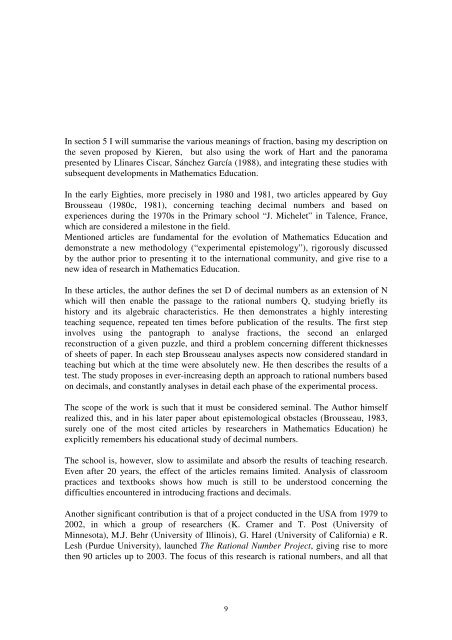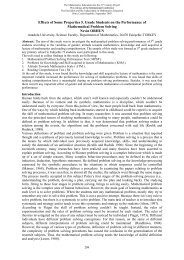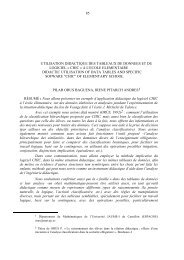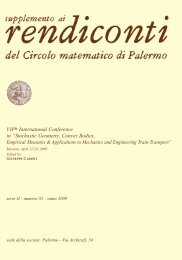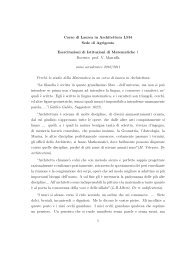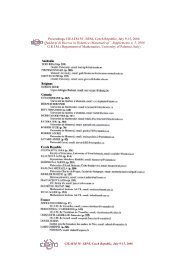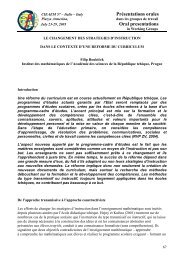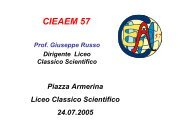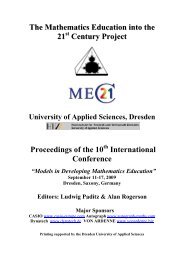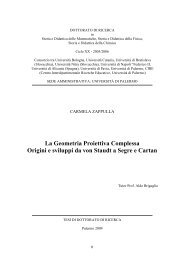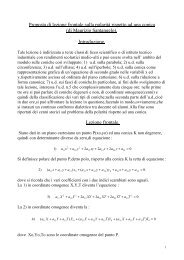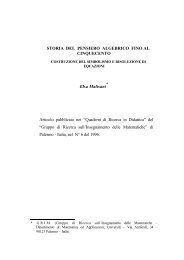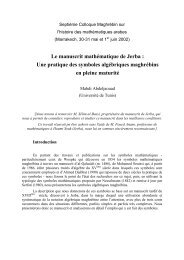Ellerbruch, 1975; Minskaya, 1975; Kieren, 1975, 1976; Muangnapoe, 1975; Williams, 1975; Galloway, 1975; Payne, 1975; Novillis, 1976; Ellerbruck, Payne, 1978; Hesemann, 1979); • operations between fraction and relative <strong>di</strong>fficulties [Sluser, 1962 (<strong>di</strong>vision); Bergen, 1966 (<strong>di</strong>vision); Wilson, 1967 (<strong>di</strong>vision); Bindwell, 1968 (<strong>di</strong>vision); Green, 1969 (multiplication); Coburn, 1973 (ad<strong>di</strong>tion and subtraction); Streefland, 1978 (subtraction)]; • <strong>di</strong>ffering interpretation of the idea of fraction [Steffe, Parr, 1968 (relation); Coburn, 1973 (relation); Suydam, 1979 (relation); Streefland (1979) (measure e relation)]. Within these pioneering stu<strong>di</strong>es, those of Kieren (1975, 1976) demonstrate the existence of at least seven <strong>di</strong>fferent meanings of the term “fraction”, showing how this polysemy is the principal reason for learning <strong>di</strong>fficulties, both concerning the general concept and operations. During the 1980s the following stu<strong>di</strong>es appeared: • learning in general (Owens, 1980; Rouchier et al., 1980; Behr, Post, Silver, Mierkiewicz, 1980; Hasemann, 1981; Behr, Lesh, Post, Silver, 1983; Lancelotti, Bartolini Bussi, 1983; Pothier, Sawada, 1983; Streefland, 1983, 1987; Hunting, 1984a, 1986; Behr, Post, Wachsmuth, 1986; Dickson, Brown, Gibson, 1984; Streefland, 1984a, b, c; Kerslake, 1986; Woodcock, 1986; Figueras, Filloy, Valdemoros, 1987; Hunting, Sharpley, 1988; Behr, Post, 1988; Ohlsson, 1988; Weame, Hiebert, 1988; Centino, 1988; Chevallard, Jullien, 1989); • learning operations between fractions [Streefland, 1982 (subtraction); Behr, Wachsmuth, Post, 1985 (ad<strong>di</strong>tion); Peralta, 1989 (ad<strong>di</strong>tion and multiplication)]; • comparisons between the values of fractions and/or decimal numbers and <strong>di</strong>fficulties in exten<strong>di</strong>ng natural numbers to fractions or decimals [Leonard, Grisvard, 1980; Nesher, Peled, 1986; Resnik et al., 1989]; • problems connected with the <strong>di</strong>ffering interpretations of the term “fraction” [Novillis, 1980a, b (positioning on the line of numbers); Ratsimba-Rajohn, 1982 (measure); Hunting, 1984b (equivalence); Wachsmuth, Lesh, Behr, 1985 (ordering); Kieren, Nelson, Smith, 1985 (partition; use of graphic algorithms); Giménez, 1986 (fractions in everyday language; <strong>di</strong>agrams); Post, Cramer, 1987 (ordering); Wachsmuth, Lesh, Behr, 1985 (ordering); Ohlsson, 1988 ( the semantics of the fraction); Davis, 1989 (the general sense of fractions in everday life); Peralta, 1989 (various graphic representations)]. Particularly significant are the stu<strong>di</strong>es of Hart (1980, 1981, 1985, 1988, 1989; with Sinkinson, 1989), based on many of the previously mentioned stu<strong>di</strong>es, and in particular the work of (Kieren, 1980, 1983, 1988; with Nelson, Smith, 1985). As we shall see, both Hart and Kieren will be active later, too. 8
In section 5 I will summarise the various meanings of fraction, basing my description on the seven proposed by Kieren, but also using the work of Hart and the panorama presented by Llinares Ciscar, Sánchez García (1988), and integrating these stu<strong>di</strong>es with subsequent developments in Mathematics Education. In the early Eighties, more precisely in 1980 and 1981, two articles appeared by Guy Brousseau (1980c, 1981), concerning teaching decimal numbers and based on experiences during the 1970s in the Primary school “J. Michelet” in Talence, France, which are considered a milestone in the field. Mentioned articles are fundamental for the evolution of Mathematics Education and demonstrate a new methodology (“experimental epistemology”), rigorously <strong>di</strong>scussed by the author prior to presenting it to the international community, and give rise to a new idea of research in Mathematics Education. In these articles, the author defines the set D of decimal numbers as an extension of N which will then enable the passage to the rational numbers Q, studying briefly its history and its algebraic characteristics. He then demonstrates a highly interesting teaching sequence, repeated ten times before publication of the results. The first step involves using the pantograph to analyse fractions, the second an enlarged reconstruction of a given puzzle, and third a problem concerning <strong>di</strong>fferent thicknesses of sheets of paper. In each step Brousseau analyses aspects now considered standard in teaching but which at the time were absolutely new. He then describes the results of a test. The study proposes in ever-increasing depth an approach to rational numbers based on decimals, and constantly analyses in detail each phase of the experimental process. The scope of the work is such that it must be considered seminal. The Author himself realized this, and in his later paper about epistemological obstacles (Brousseau, 1983, surely one of the most cited articles by researchers in Mathematics Education) he explicitly remembers his educational study of decimal numbers. The school is, however, slow to assimilate and absorb the results of teaching research. Even after 20 years, the effect of the articles remains limited. Analysis of classroom practices and textbooks shows how much is still to be understood concerning the <strong>di</strong>fficulties encountered in introducing fractions and decimals. Another significant contribution is that of a project conducted in the USA from 1979 to 2002, in which a group of researchers (K. Cramer and T. Post (University of Minnesota), M.J. Behr (University of Illinois), G. Harel (University of California) e R. Lesh (Purdue University), launched The Rational Number Project, giving rise to more then 90 articles up to 2003. The focus of this research is rational numbers, and all that 9
- Page 1: CONTENTS 1. Fractions: conceptual a
- Page 4 and 5: In this way the initial set N×(N-{
- Page 6 and 7: Thus fractions, while not a part of
- Page 10 and 11: accompanies them in the field of
- Page 12 and 13: There are many studies based on cla
- Page 14 and 15: primary classes. The study focuses
- Page 16 and 17: on proportion (Fernández, 2001), a
- Page 18 and 19: Thus it is evident that the choice
- Page 20 and 21: We can pass to other examples, abst
- Page 22 and 23: (a) The image of a whole divided in
- Page 24 and 25: Behr M.J., Wachsmuth I., Post T. (1
- Page 26 and 27: multiplicative reasoning in the lea
- Page 28 and 29: Duval R. (1995). Sémiosis et pens
- Page 30 and 31: Hunting R.P., Pepper K.I., Gibson S
- Page 32 and 33: Novillis C.F. (1976). An analysis o
- Page 34 and 35: Steffe L.P., Olive J. (1990). Const
- Page 36 and 37: Vogel K. (1958). Vorgriechische mat
- Page 38 and 39: Indice Prefazione di Athanasios Gag
- Page 40 and 41: 7.1.8. Difficoltà nel passare da u
- Page 42 and 43: L’idea di presentare in un unico
- Page 44 and 45: Questo libro, che ora vede la luce,
- Page 46 and 47: 1 Dai numeri naturali ai razionali
- Page 48 and 49: • a volte parrebbe anche lecito e
- Page 50 and 51: Stando così le cose, l’insieme N
- Page 52 and 53: tale che 1 2 a + b 2 1 2 = . La cos
- Page 54 and 55: faccio notare solo che l’immagine
- Page 56 and 57: Applicando la formula appena trovat
- Page 58 and 59:
“bastoncello” (da “virga”,
- Page 60 and 61:
dichiara lo stesso scriba. Contiene
- Page 62 and 63:
Per indicare un numero naturale, si
- Page 64 and 65:
3 per 4 1 Anche la frazione , per l
- Page 66 and 67:
modificavano (com’è accaduto per
- Page 68 and 69:
In effetti, però, le scritture not
- Page 70 and 71:
Per esempio, in una tavola redatta
- Page 72 and 73:
Attorno al 2700 a. C. si fa strada
- Page 74 and 75:
Come ho già ricordato, alla civilt
- Page 76 and 77:
scriviamo nei nostri caratteri attu
- Page 78 and 79:
Verso il 200 a. C. (c’è chi dice
- Page 80 and 81:
Tuttavia il sistema tenne per molti
- Page 82 and 83:
algoritmi di calcolo sui numeri nat
- Page 84 and 85:
Un fatto nuovo si ebbe con Leonardo
- Page 86 and 87:
Johann Gutenberg (1400 circa - 1468
- Page 88 and 89:
3 _________________________________
- Page 90 and 91:
di quasi tutte le nazioni del mondo
- Page 92 and 93:
4 _________________________________
- Page 94 and 95:
• il numero che si trova sopra ta
- Page 96 and 97:
attraverso attività fatte al panto
- Page 98 and 99:
costruirne una salda idea, prima di
- Page 100 and 101:
attraverso le risposte e le domande
- Page 102 and 103:
degli allievi. L’importanza del r
- Page 104 and 105:
5 _________________________________
- Page 106 and 107:
6 possibile trovare i di 12; ma que
- Page 108 and 109:
Per completare il quadro realistico
- Page 110 and 111:
1 sia da considerarsi come del rett
- Page 112 and 113:
l’operazione di divisione (solo i
- Page 114 and 115:
avrebbe dovuto essere: «Trovare la
- Page 116 and 117:
Dovremmo avere molti dubbi nell’a
- Page 118 and 119:
5.8. LA FRAZIONE COME PUNTO DI UNA
- Page 120 and 121:
Insomma, anche se le scritture mate
- Page 122 and 123:
persone ed i commensali diventano 6
- Page 124 and 125:
cronologico, anche per mostrare com
- Page 126 and 127:
La concettualizzazione così intesa
- Page 128 and 129:
6 _________________________________
- Page 130 and 131:
appresentazione semiotica: un mezzo
- Page 132 and 133:
2003a): «(…)da una parte, l’ap
- Page 134 and 135:
Duval accorda alla conversione un p
- Page 136 and 137:
Anzi, a questo punto (o forse addir
- Page 138 and 139:
Ordine tra frazione e numero scritt
- Page 140 and 141:
visto che quella classica, che pass
- Page 142 and 143:
lo studente potrebbe non sapere com
- Page 144 and 145:
x o il doppio di ?». Le risposte p
- Page 146 and 147:
È invece fondamentale dare eserciz
- Page 148 and 149:
Non entrerò in dettaglio con molti
- Page 150 and 151:
metterà in gioco; semplicemente so
- Page 152 and 153:
«“Immagine mentale” è il risu
- Page 154 and 155:
si calcola quanti contenitori servo
- Page 156 and 157:
modello e lo studente cercherà alt
- Page 158 and 159:
7.2.5. Ostacoli ontogenetici, didat
- Page 160 and 161:
conoscenza che però diventa modell
- Page 162 and 163:
Gli esempi potrebbero proseguire a
- Page 164 and 165:
Per quanto riguarda le frazioni, no
- Page 166 and 167:
Si tratta di mettere sempre in evid
- Page 168 and 169:
7. 3 A proposito di non senso, espr
- Page 170 and 171:
13. La ricerca mostra come sia nece
- Page 172 and 173:
22. La trasposizione didattica* è
- Page 174 and 175:
implica anche un “voler fare”,
- Page 176 and 177:
Matematica e linguaggio. Apprendime
- Page 178 and 179:
sta pensando alla formazione di un
- Page 180 and 181:
Diventa allora spontaneo considerar
- Page 182 and 183:
Sviluppare competenza matematica. T
- Page 184 and 185:
Ma la cosa a mio avviso più import
- Page 186 and 187:
• Richiesta epistemologica: è co
- Page 188 and 189:
Bibliografia Barón C., Lotero M.,
- Page 190 and 191:
metaforico). La tensione umana non
- Page 192 and 193:
Matematica con un grande carico di
- Page 194 and 195:
Per giungere ad un apprendimento ch
- Page 196 and 197:
• a partire dalle condizioni epis
- Page 198 and 199:
didattica. 4. 404-419. Chevallard Y
- Page 200 and 201:
1. Marco teórico en el cual se sit
- Page 202 and 203:
tiempo un ejercicio o un problema,
- Page 204 and 205:
exigidas, tanto para el grado que e
- Page 206 and 207:
2. Problemas de investigación Ante
- Page 208 and 209:
H3. En relación con el problema de
- Page 210 and 211:
abandonaba). En este punto se forma
- Page 212 and 213:
Test 2.4 Mide el área de este tri
- Page 214 and 215:
Test de control para 2.2 10 cm Test
- Page 216 and 217:
temor, reduciéndolo. Así fue, gra
- Page 218 and 219:
mejor forma para cambiar la idea de
- Page 220 and 221:
casilla coloreada, es: «(¿Cuáles
- Page 222 and 223:
• Apprendimento di concettiAppren
- Page 224 and 225:
matematica sono stati parecchio stu
- Page 226 and 227:
La competenza matematica La compete
- Page 228 and 229:
D’Amore B. (1999). Elementi di di
- Page 230 and 231:
c) misurare lo stato cognitivo di o
- Page 232 and 233:
discipline; c’è chi li chiama
- Page 234 and 235:
strettamente connessi alla minisitu
- Page 236 and 237:
2.3. Prima di procedere, evidenzio
- Page 238 and 239:
al Ministero per una certa discipli
- Page 240 and 241:
Sul fenomeno della “scolarizzazio
- Page 242 and 243:
secundaria superior en el ámbito d
- Page 244 and 245:
3. Primera referencia de los sujeto
- Page 246 and 247:
En los procesos de descubrimiento o
- Page 248 and 249:
dos semestres diferentes de 60 hora
- Page 250 and 251:
Dentro de pocos meses escribiremos
- Page 252 and 253:
(P) [La matemática es] Prototipo d
- Page 254 and 255:
(P) Pensaba a mi mismo como quien g
- Page 256 and 257:
SSIS que dan a disposición de la d
- Page 258 and 259:
conclusión. Sostiene que tuvo form
- Page 260 and 261:
Schoenfeld A.H. (1992). Learning to
- Page 262 and 263:
système “d’actions intérioris
- Page 264 and 265:
“variété didactique” du conce
- Page 266 and 267:
conséquente vision conception plat
- Page 268 and 269:
de soumettre à son pouvoir ses pro
- Page 270 and 271:
l’idéalisation de l’indépenda
- Page 272 and 273:
concept de diversité d’utilisati
- Page 274:
Klausmeier H.J. (1979). Un modello


